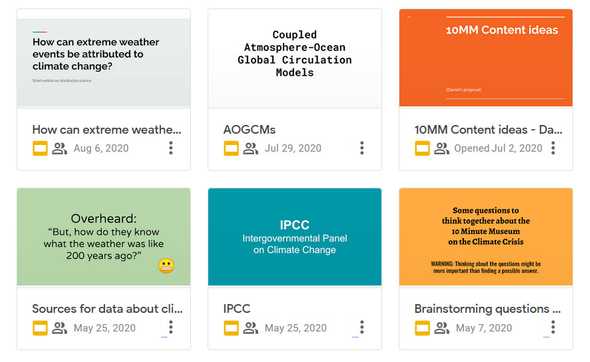Tools for research and collaboration
October 15, 2020
After we had fixed our museum’s topic to be the Climate Crisis, we had to begin the research. Since researching scientific subjects is a whole blog post of its own, we will focus on the specific tools we used for our internal communication and brainstorming. After all, working in teams can sometimes be very challenging. Our team consists of 8 people, each with different background (mathematics, computer science, humanities, etc.) and their own expectations for the project. So: communication and a healthy team dynamic are key! These tools helped us to establish them.
Slack
In large part, we communicate internally with Slack, a chat program that offers text, sound, and video conference functions. Every one of IMAGINARY’s projects has a separate Slack channel in which we can share everything that we have on our mind and inspiring resources related to the topic. Sending emails around is a significant stressor; organizing them can be twice as tiresome. Slack allows us to manage posts nicely and also comment as much as we like.
Google Docs
The next thing that we set up was a Google Document to collect all the interesting resources we wanted to show to our team members. Google Docs is a collaboration platform, which means that it allows all team members to edit text documents together. To find out how the Climate Crisis is commonly communicated to the public, the process of searching the web has been indispensable.
MURAL
After each team member had done their research and looked at the shared resources in the Google Document, we set up our first team meeting, where we used MURAL to have a joint brainstorming session. MURAL offers collaborative virtual white spaces on which people can arrange virtual Post-It Notes. We used those to collect topics that seemed interesting to us. After that, every team member voiced their opinions to decide which topics we should pursue deeper.
Google Slides
After the first brainstorming session was over, we set up the following team meetings as presentation sessions. Each team member brought a specific topic to the session that they would elaborate on. What was important here was not only the scientific and societal relevance of the topics but also if and how we could imagine them being turned into an exhibit. We conceived this as more in-depth brainstorming, hoping that after looking at different topics, we would find ways to connect them into a story. In the image above, you will see some of the presentations we prepared on topics like Attribution Studies, Paleoclimatology, the IPCC, etc.


